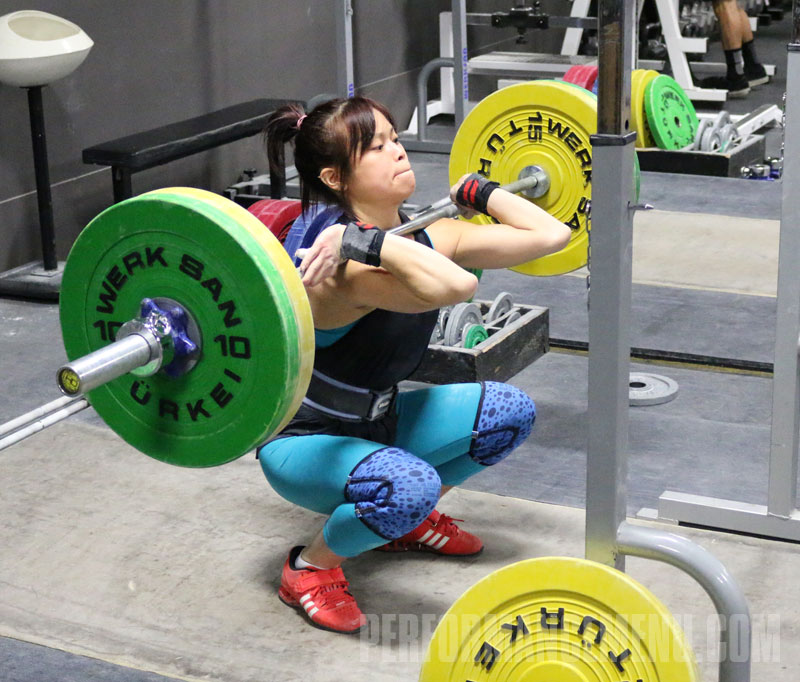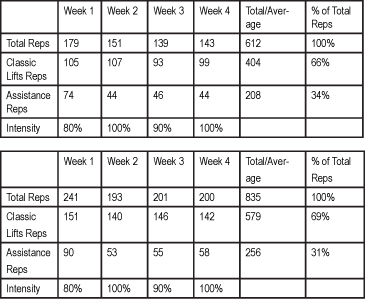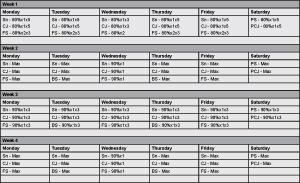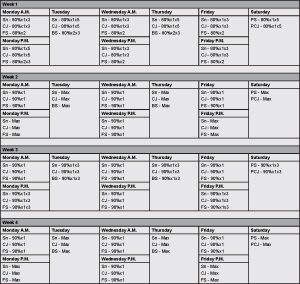Junior Weightlifting Program

The following training program is designed for the full-time weightlifter and someone who has the potential to make a Junior World Championship team. You would have to be borderline crazy to train this much if you lacked the talent to make such a team. That being said, this program is ideal for the college-age weightlifter, with classes at various times throughout the day, time can be built in for twice-daily training; it requires only a little planning and a lot of dedication—the program rotates months (really 4 week periods) of six and nine trainings per week.
This “Junior” training program should be planned around the two major contests for a top level junior lifter— the USAW Junior Nationals (typically March) and the Junior World Championships (typically June). Table 1.1 displays a sample of how the Junior program as well as a couple of the previous training programs should be built into the yearly training. If you’re looking for a starting point it would be in July; it would be preceded by a couple weeks of easy to almost no training in the two weeks or so since the Junior Worlds. Then over the next couple months the training intensity would slowly be increased by simply changing programs until you reach the Junior program in October to begin the real training for the competitive season.

While I said that this program is designed to coincide with the two major contests facing a junior-aged lifter, the truth is that when you train with almost nothing but snatch and clean and jerk you are ready at the very least to lift PR equaling weights in any contest, anytime. Ideally, though, you would prefer to not have a contest during the months with nine trainings as this becomes quite demanding. It is possible to do and perform well, but it works better to have the local contest or non-essential national contest (ex. American Open) during the six training per week months. The only difference between preparing for these types of contests is that there should be no “tapering” during the contest week. It has been our experience that if you taper the workouts down preparing for non-essential contests you lose the “trained state” that Ivan Abadjiev has spoken about and it makes it much harder to resume training on Monday. However, if you keep training hard and avoid tapering you will be able to lift in the contest and resume Monday training just fine. We have actually done this during a period of training nine times a week—training twice the day before the local meet—and were still able to tie all three PRs.

Table 1.2 is a summary of the training during the periods of six trainings per week. Now the classic lifts make up two-thirds of the training volume and the intensity of the workouts now include two-out-of-four weeks of training at 100%. Despite the obvious decrease in repetitions in the assistance exercises (squats and powers), the squats are done five days a week, but the powers are relegated to the weekend. Also, during these high-intensity periods (six and nine workouts) pulls have been abandoned completely. The only exercises used are those that will directly impact the competition results and increase the productivity of training.
In table 1.3 summarizing nine-trainings per week the percentage of classic lifts increases to 69% as each of the three morning workouts includes more snatches and clean and jerks. When you have the ability to train at 90% in the morning and then 90% or max again in the afternoon you are in the best possible position to perform well in a competition anytime anywhere.
The workout itself is pretty straightforward—snatch, clean and jerk and squat, repeat. When we are training at 80% or 90%, we try to add 1kg or 1% in the snatch a day and 2kg or 2% a day in the clean and jerk and squat except for Wednesday. If you notice Wednesday is slightly different from the other days of the week, serving as a mid-week back off day. Adding weight the other days makes transitioning to the following week much easier because by the end of the week you’re at 85% or 95% doing it for multiple sets and you have sense of making progress during the week.
For the most part, the rest of the workout is self-explanatory. So you might say where do we go from here? The next step would be to train twice-a-day every day during the heaviest periods. Currently I do not have anyone ready to train that much, so it would not be appropriate for me to speculate on something that I have not used myself.
So there you have it, all of our programs in full. Give them a try yourself or with your team and see what happens—like it says on the back of our shirt: “You have nothing to lose but your weakness.”
Six Trainings per Week

Nine Trainings per Week

This “Junior” training program should be planned around the two major contests for a top level junior lifter— the USAW Junior Nationals (typically March) and the Junior World Championships (typically June). Table 1.1 displays a sample of how the Junior program as well as a couple of the previous training programs should be built into the yearly training. If you’re looking for a starting point it would be in July; it would be preceded by a couple weeks of easy to almost no training in the two weeks or so since the Junior Worlds. Then over the next couple months the training intensity would slowly be increased by simply changing programs until you reach the Junior program in October to begin the real training for the competitive season.

While I said that this program is designed to coincide with the two major contests facing a junior-aged lifter, the truth is that when you train with almost nothing but snatch and clean and jerk you are ready at the very least to lift PR equaling weights in any contest, anytime. Ideally, though, you would prefer to not have a contest during the months with nine trainings as this becomes quite demanding. It is possible to do and perform well, but it works better to have the local contest or non-essential national contest (ex. American Open) during the six training per week months. The only difference between preparing for these types of contests is that there should be no “tapering” during the contest week. It has been our experience that if you taper the workouts down preparing for non-essential contests you lose the “trained state” that Ivan Abadjiev has spoken about and it makes it much harder to resume training on Monday. However, if you keep training hard and avoid tapering you will be able to lift in the contest and resume Monday training just fine. We have actually done this during a period of training nine times a week—training twice the day before the local meet—and were still able to tie all three PRs.

Table 1.2 is a summary of the training during the periods of six trainings per week. Now the classic lifts make up two-thirds of the training volume and the intensity of the workouts now include two-out-of-four weeks of training at 100%. Despite the obvious decrease in repetitions in the assistance exercises (squats and powers), the squats are done five days a week, but the powers are relegated to the weekend. Also, during these high-intensity periods (six and nine workouts) pulls have been abandoned completely. The only exercises used are those that will directly impact the competition results and increase the productivity of training.
In table 1.3 summarizing nine-trainings per week the percentage of classic lifts increases to 69% as each of the three morning workouts includes more snatches and clean and jerks. When you have the ability to train at 90% in the morning and then 90% or max again in the afternoon you are in the best possible position to perform well in a competition anytime anywhere.
The workout itself is pretty straightforward—snatch, clean and jerk and squat, repeat. When we are training at 80% or 90%, we try to add 1kg or 1% in the snatch a day and 2kg or 2% a day in the clean and jerk and squat except for Wednesday. If you notice Wednesday is slightly different from the other days of the week, serving as a mid-week back off day. Adding weight the other days makes transitioning to the following week much easier because by the end of the week you’re at 85% or 95% doing it for multiple sets and you have sense of making progress during the week.
For the most part, the rest of the workout is self-explanatory. So you might say where do we go from here? The next step would be to train twice-a-day every day during the heaviest periods. Currently I do not have anyone ready to train that much, so it would not be appropriate for me to speculate on something that I have not used myself.
So there you have it, all of our programs in full. Give them a try yourself or with your team and see what happens—like it says on the back of our shirt: “You have nothing to lose but your weakness.”
Six Trainings per Week

Nine Trainings per Week

|
Ryan Kyle is the coach of Sandusky Weightlifting and the strength coach for St. Mary's Central Catholic High School in Sandusky, Ohio. He is a USA Weightlifting club coach and his lifters have medaled at the Youth Pan-American Championships and have been Junior World Team members. |
Search Articles
Article Categories
Sort by Author
Sort by Issue & Date
Article Categories
Sort by Author
Sort by Issue & Date

